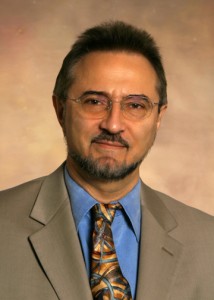
Valery Levitas, Schafer Professor and faculty member of aerospace engineering and mechanical engineering, found a strict and simple solution to the classical problem in the interface and surface science formulated by J. W. Gibbs in the 19th century. Namely, he uncovered a way to define the position of a dividing surface.
The Gibbsian view of a dividing surface, or sharp interface, is a mathematically constructed thin layer between two phases. Not knowing the position of a dividing surface creates numerous problems when defining properties of nonequilibrium interfaces, in particular, interface energy and stresses.
For more than a century, there was no defined way to determine the dividing surface. Surprisingly, Levitas uncovered the solution from a completely different discipline – statics, and more specifically, the principle of static equivalence (Levitas V.I., Physical Review B 89, 094107 (2014) DOI: 10.1103/PhysRevB.89.094107).
Combining his expertise in phase transformation research with this statics principle, Levitas determined that the dividing surface is statically equivalent to a nonequilibrium finite-width interface with distributed tensile stresses if it has (a) the same resultant force equal to interface energy and (b) the same moment, which reaches zero (or equal to zero) about dividing surface.
Ironically, even if these two conditions were found, they may be potentially inconsistent with each other. So, Levitas utilized some new results within the phase field approach and a corresponding analytical treatment to demonstrate that these conditions are actually consistent.
The results of his study are applicable to all types of interfaces, including those between different phases in multiphase and composite materials, grain and twin boundaries, and external surfaces.
“If I did not teach undergraduate statics, I would not have formulated this interface science problem as a simple statics problem and would not have solved it,” said Levitas. “While it only took a few hours to solve the problem, it took more than a century to formulate it in such a way that it could be solved.”
Levitas plans to include this problem in his statics class, continuing his trend of incorporating nontraditional problems, like high-pressure physics, reaction of nanoparticles, and material synthesis under high pressure and shear problems, in the course. He says these concepts are important to show students because they demonstrate a broad application of statics in science and engineering.